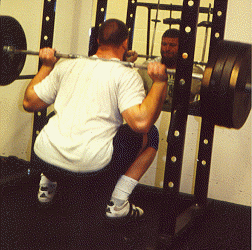FOR ATHLETIC WEIGHT TRAINING
By: J.V. Askem

An example of a proper Athletic Weight Training
Back Sided Squat.

When performing exercises for Athletic Weight Training it is important to always do your exercises with the fullest range of motion possible, with the strictest form possible. If you cheat and cut the movements short, you're just cheating yourself. Squats should not be treated any differently.
1. Face the squat stands and position yourself under the barbell. Then rise up to where the barbell is on your shoulders behind your neck.
2. Maintain a grip close to your shoulders. This will initiate a pulling of your shoulder blades together behind you, which will allow you to sit more upright.
3. Take a deep breath in as you lift the bar off of the stands or rack. Once off let the air out of your lungs as you step back to position yourself.
4. Stand with your feet under your arm pits and angle your toes out slightly.
5. Look straight ahead at a spot on the wall in front of you about belt height. Thus you will be looking down slightly at the start, but straight ahead at the bottom position.
6. Take in a deep breath and descend deliberately. Remain as upright as possible and descend as low as you can go as long as you can remain as upright as possible.
7. To rise let the air out of your lungs and reverse the descending motion. Stay as upright as possible through the entire movement while looking at the same spot on the wall.
Note 1: If you can not remain in a proper upright position, then your form should be evaluated as to why. The solution might be something simple like a different pair of shoes. However, do NOT try to practice full squats if you have a pre existing condition that prevents you from executing the proper form. In most cases, lack of proper flexibility is the reason proper form can not be maintained.
Note 2: It is possible that such squats may not be safe for some individuals. Example: individuals with long legs and a short torso may not be able to stay erect at the full bottom position without rounding their backs forward. Such individuals may also have to lean forward more to maintain their balance. If this is the case, stop descending down as soon as your back starts to round forward.
Good luck with your training. JVA